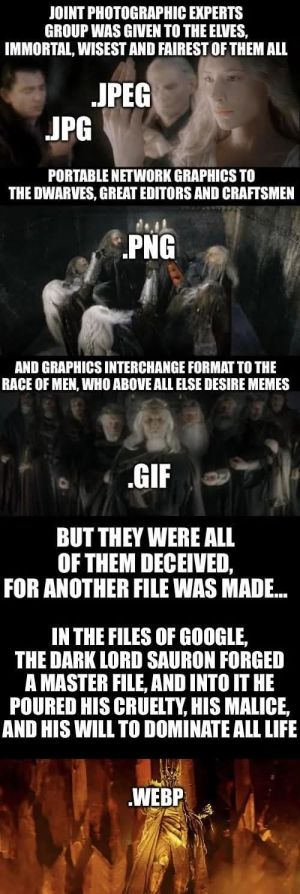WebP

Ring of Controversy: How WebP Became the Most Hated File Format (That Nobody Asked For)
The internet is a vast landscape, filled with countless kingdoms vying for dominance. In the realm of image file formats, JPEG, PNG, and GIF have long held sway. But a challenger arose, promising a crown forged in efficiency – the WebP.
A Web-Woven Wonder:
Developed by Google, WebP boasted impressive compression rates, offering superior quality at a fraction of the size of its JPEG counterparts. This made it ideal for the web, where faster loading times are paramount. Browsers quickly pledged allegiance, readily displaying WebPs in all their glory.
The Dark Side of the Ring:
However, WebP's reign soon encountered a snag. Unlike its established rivals, WebP lacked widespread support outside the browser realm. Editing software struggled to recognize it, and many devices, particularly older models, couldn't display it at all. This created a frustrating situation for users who downloaded a WebP image, only to be met with a confusing error message.
One Format to Rule Them All? Not Quite.
The dream of a single, all-encompassing image format quickly turned into a nightmare for some. Content creators found themselves stuck in a conversion conundrum. Should they prioritize web performance with WebP, alienating users with incompatible devices? Or should they stick with established formats, sacrificing some speed for wider accessibility?
The Great Image Format War Continues:
The battle for image format dominance continues. While WebP enjoys the favor of web browsers, its lack of universal support keeps it from claiming the ultimate victory. JPEG remains a reliable choice for photos, while PNG maintains its throne for graphics with transparency. Even the dethroned GIF continues to hold a special place in our hearts (and internet memes).
The Moral of the Story?
In the realm of image formats, a one-size-fits-all approach rarely prevails. Understanding the strengths and weaknesses of each format is key to creating and delivering content that is both visually appealing and accessible to your target audience.
The Final Pixel:
WebP may have promised a unified image kingdom, but its reign remains limited. The internet, it seems, thrives on diversity, with each format serving a unique purpose. So, the next time you choose a file format, remember, there's no single "ring" to rule them all.